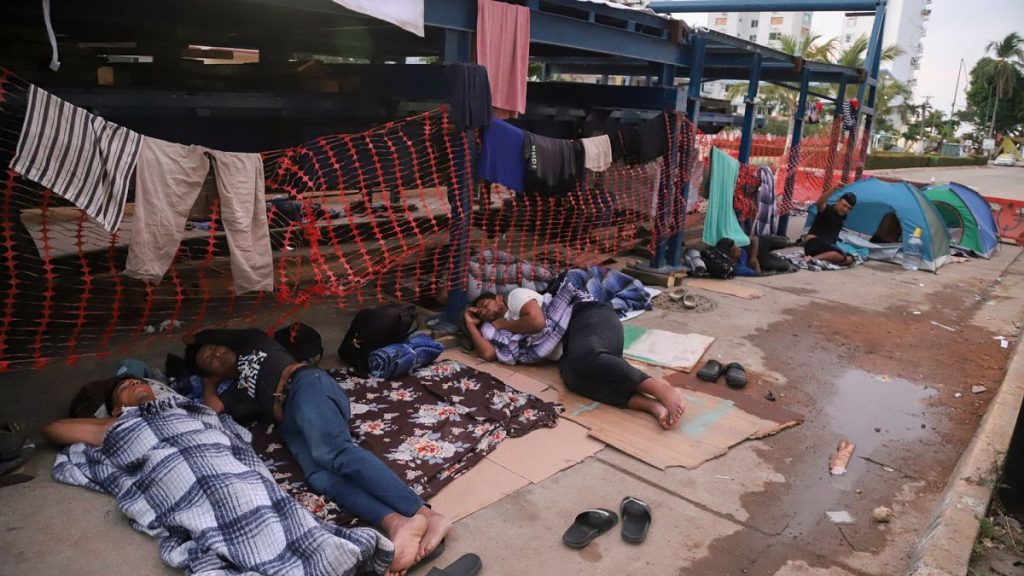The plight of migrants in Mexico has intensified, with many finding themselves stranded and disillusioned after being misled by authorities. Lured by promises of transit permits and support to continue their northward journey, primarily to the United States, these individuals, hailing from various countries, are often transported to cities like Acapulco, only to be left without resources, clear direction, or valid documentation. This practice, part of a broader Mexican government strategy to disperse migrant caravans and prevent large-scale arrivals at the US border, has left many vulnerable and exposed to precarious conditions. The policy, implemented in response to pressure from the United States, aims to reduce visible migrant flows and appease demands for stricter border control. However, the execution of this policy has raised serious concerns about the well-being and safety of the migrants themselves.
Acapulco, a city still recovering from the devastating impact of Hurricane Otis in 2023 and grappling with high levels of organized crime and violence, becomes an unlikely and unsuitable destination for these displaced individuals. Instead of finding the promised assistance and safe passage, they are often left to fend for themselves in a city ill-equipped to handle the influx. The deceptive tactics employed by immigration officials, promising permits that allow free transit across Mexico, only to issue documents restricting movement to the state of Guerrero, further exacerbate their predicament. This leaves migrants like Ender Antonio Castañeda, a 28-year-old Venezuelan, feeling betrayed and abandoned, stranded without the means to continue their journey or return home. The disconnect between promises made and the reality on the ground creates a sense of despair and vulnerability among those seeking refuge and opportunity.
The dismantling of migrant caravans, a recurring pattern in recent weeks, further highlights the Mexican government’s approach to managing migration flows. Authorities often employ a strategy of allowing caravans to proceed for days, exhausting the migrants physically and emotionally, before offering bus transportation to various cities under the pretense of processing their immigration status. This tactic, described by some as “dispersion and exhaustion,” effectively breaks up large groups and distributes them across the country, making them less visible and reducing the pressure on border crossings. However, this dispersal often leads to migrants being placed in locations lacking adequate resources and support systems, further exacerbating their precarious situation.
The underlying fear and uncertainty that permeate the migrant experience are compounded by the precarious security situation in many parts of Mexico. Drug cartels frequently target migrants for kidnapping and extortion, exploiting their vulnerability and desperation. Even the act of boarding a bus becomes fraught with anxiety for individuals like Dayani Sánchez, a 33-year-old Cuban migrant, who fears being intercepted and targeted by criminal groups. While the Mexican government maintains that its immigration strategy is rooted in humanitarian principles, critics argue that dispersing migrants to areas known for violence and instability contradicts this claim, exposing them to significant risks and undermining their safety.
The burden of providing for these stranded individuals often falls upon local communities and religious organizations. Catholic churches in Acapulco have become sanctuaries, offering food, water, clothing, and temporary shelter to those in need. However, the sheer number of migrants and the ongoing nature of the crisis strain these limited resources. Reverend Leopoldo Morales, a priest in Acapulco, acknowledges the immense challenges faced by migrants arriving without money and facing an uncertain future. The goodwill and compassion of local communities and faith-based organizations play a crucial role in mitigating the hardships faced by these individuals, but a more comprehensive and sustainable solution is needed.
The stories of migrants like Jorge Neftalí Alvarenga, a Honduran migrant who expressed relief at escaping the challenging conditions in Chiapas but also frustration at the deception he experienced, reflect the complex and often contradictory emotions that characterize the migrant journey. While grateful for the temporary respite, he feels betrayed by the unfulfilled promises of work opportunities in cities like Mexico City or Monterrey. The experience of being misled and stranded, far from their intended destination, underscores the broken promises and systemic challenges that migrants face as they navigate the complexities of the immigration system and seek a better life. The gap between the rhetoric of humanitarian assistance and the reality of their lived experiences reveals a deeper systemic issue that requires urgent attention.














